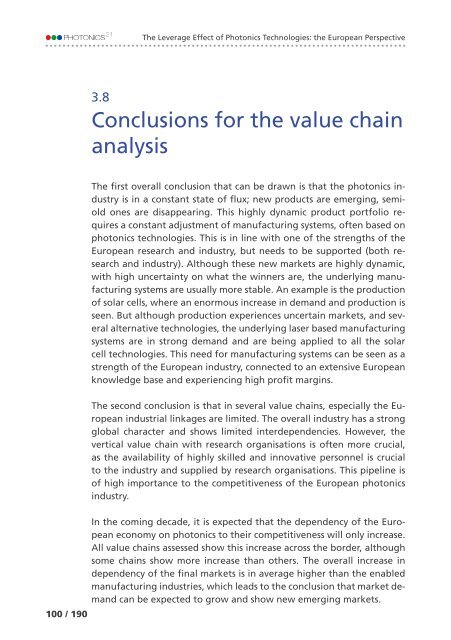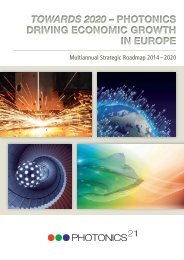of Photonics Technologies: the European Perspective The Leverage Effect
You also want an ePaper? Increase the reach of your titles
YUMPU automatically turns print PDFs into web optimized ePapers that Google loves.
<strong>The</strong> <strong>Leverage</strong> <strong>Effect</strong> <strong>of</strong> <strong>Photonics</strong> <strong>Technologies</strong>: <strong>the</strong> <strong>European</strong> <strong>Perspective</strong><br />
3.8<br />
Conclusions for <strong>the</strong> value chain<br />
analysis<br />
<strong>The</strong> first overall conclusion that can be drawn is that <strong>the</strong> photonics industry<br />
is in a constant state <strong>of</strong> flux; new products are emerging, semiold<br />
ones are disappearing. This highly dynamic product portfolio requires<br />
a constant adjustment <strong>of</strong> manufacturing systems, <strong>of</strong>ten based on<br />
photonics technologies. This is in line with one <strong>of</strong> <strong>the</strong> strengths <strong>of</strong> <strong>the</strong><br />
<strong>European</strong> research and industry, but needs to be supported (both research<br />
and industry). Although <strong>the</strong>se new markets are highly dynamic,<br />
with high uncertainty on what <strong>the</strong> winners are, <strong>the</strong> underlying manufacturing<br />
systems are usually more stable. An example is <strong>the</strong> production<br />
<strong>of</strong> solar cells, where an enormous increase in demand and production is<br />
seen. But although production experiences uncertain markets, and several<br />
alternative technologies, <strong>the</strong> underlying laser based manufacturing<br />
systems are in strong demand and are being applied to all <strong>the</strong> solar<br />
cell technologies. This need for manufacturing systems can be seen as a<br />
strength <strong>of</strong> <strong>the</strong> <strong>European</strong> industry, connected to an extensive <strong>European</strong><br />
knowledge base and experiencing high pr<strong>of</strong>it margins.<br />
<strong>The</strong> second conclusion is that in several value chains, especially <strong>the</strong> <strong>European</strong><br />
industrial linkages are limited. <strong>The</strong> overall industry has a strong<br />
global character and shows limited interdependencies. However, <strong>the</strong><br />
vertical value chain with research organisations is <strong>of</strong>ten more crucial,<br />
as <strong>the</strong> availability <strong>of</strong> highly skilled and innovative personnel is crucial<br />
to <strong>the</strong> industry and supplied by research organisations. This pipeline is<br />
<strong>of</strong> high importance to <strong>the</strong> competitiveness <strong>of</strong> <strong>the</strong> <strong>European</strong> photonics<br />
industry.<br />
100 / 190<br />
In <strong>the</strong> coming decade, it is expected that <strong>the</strong> dependency <strong>of</strong> <strong>the</strong> <strong>European</strong><br />
economy on photonics to <strong>the</strong>ir competitiveness will only increase.<br />
All value chains assessed show this increase across <strong>the</strong> border, although<br />
some chains show more increase than o<strong>the</strong>rs. <strong>The</strong> overall increase in<br />
dependency <strong>of</strong> <strong>the</strong> final markets is in average higher than <strong>the</strong> enabled<br />
manufacturing industries, which leads to <strong>the</strong> conclusion that market demand<br />
can be expected to grow and show new emerging markets.






